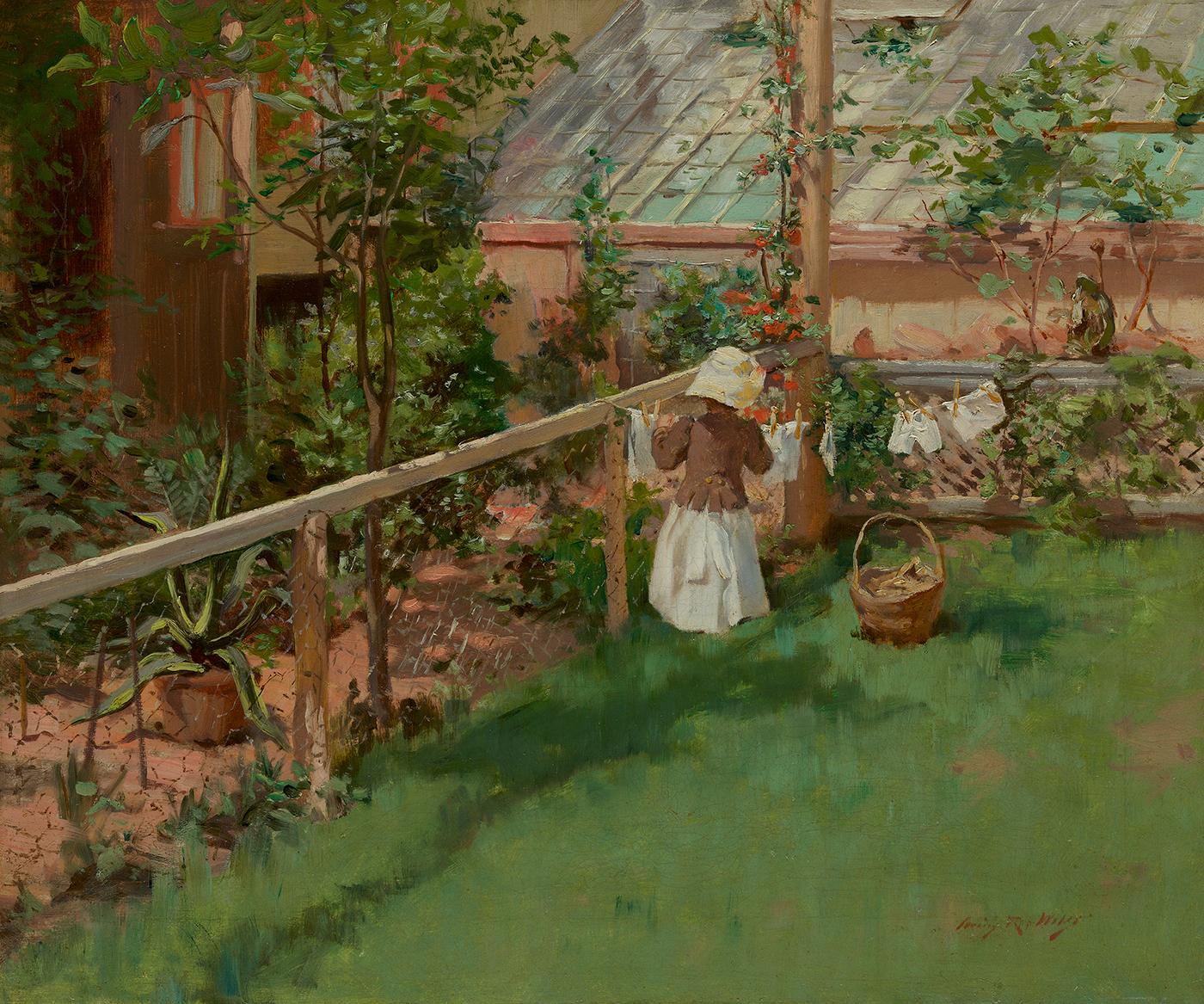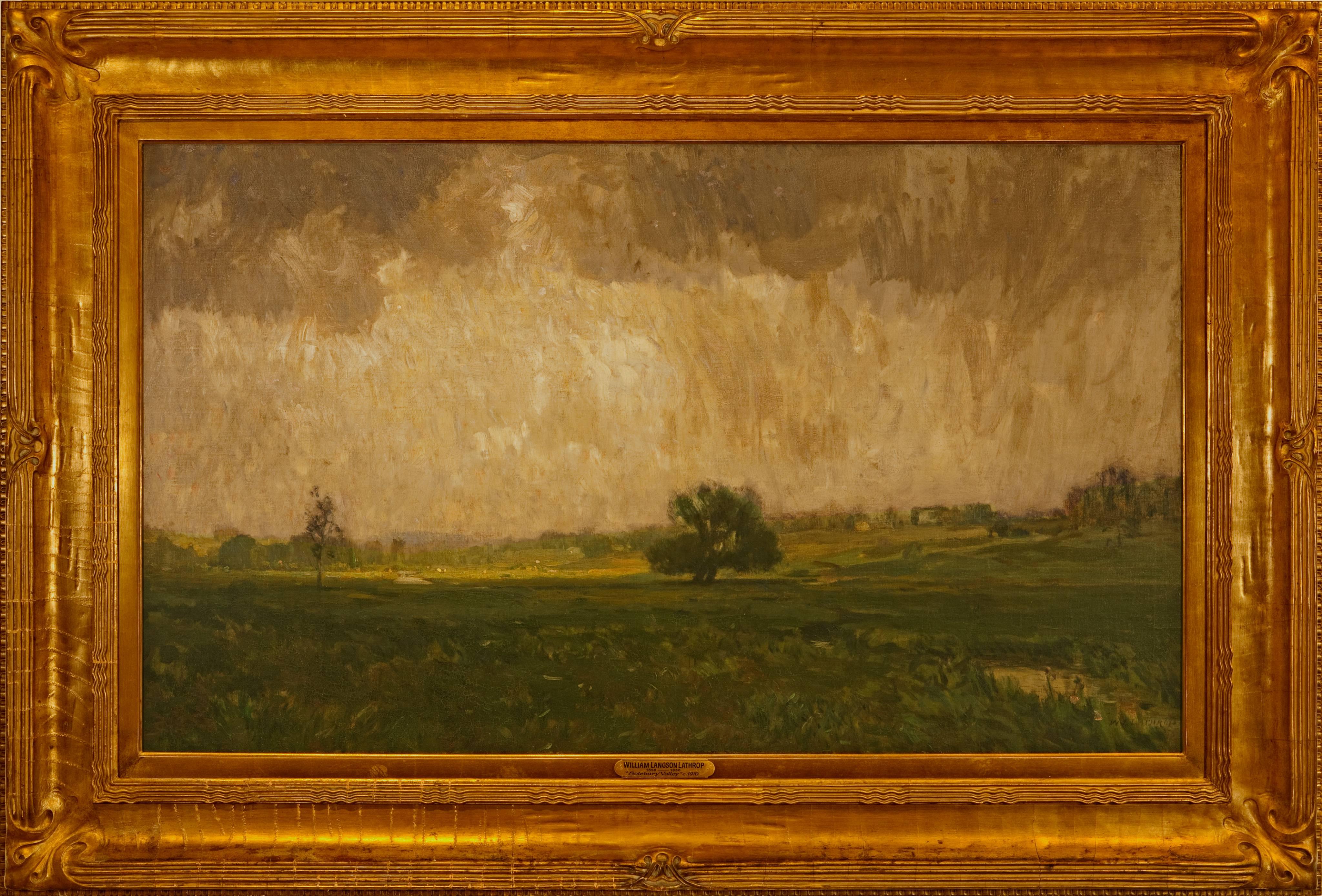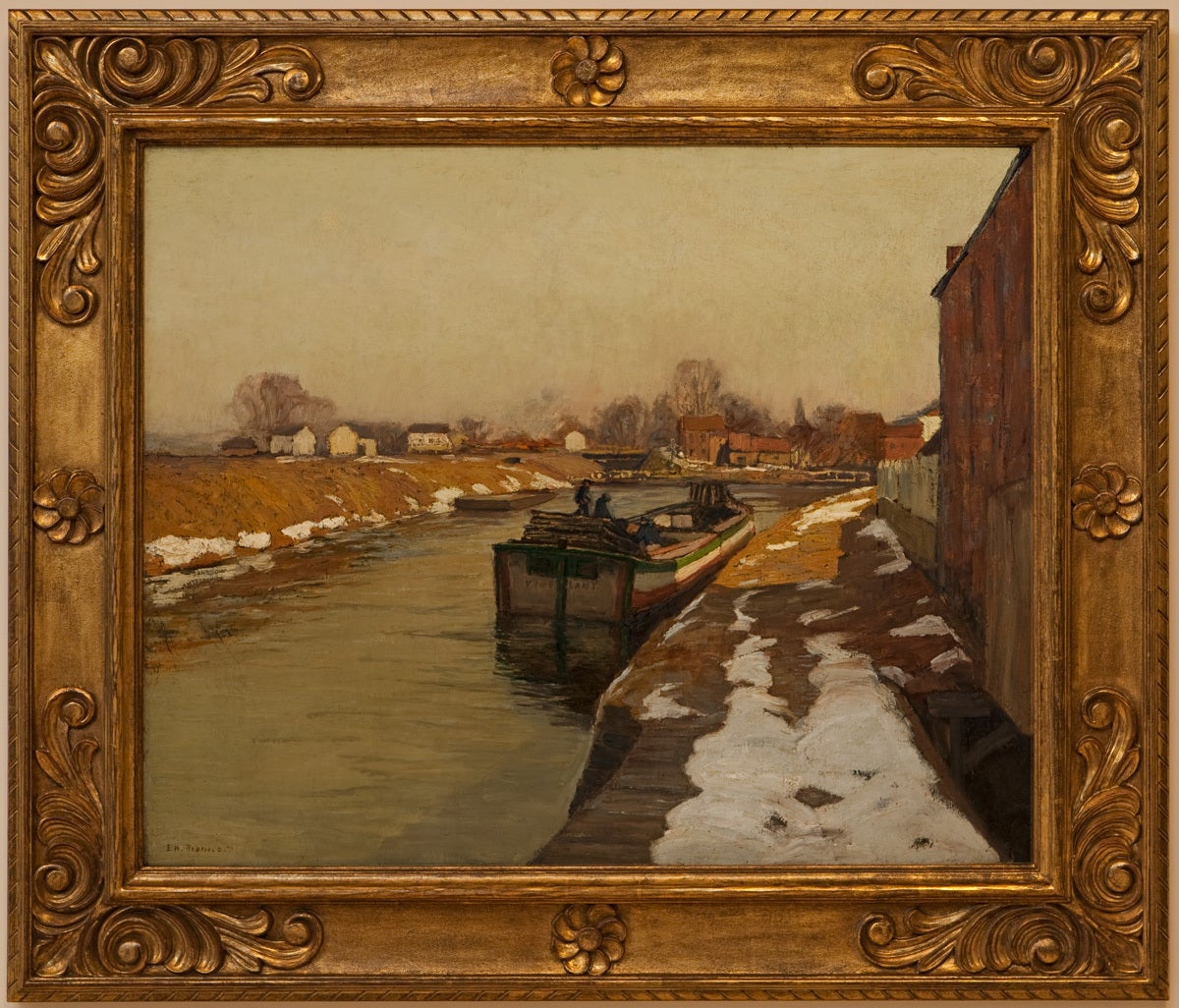Items Similar to Badlands (South Dakota) - Plein Air Landscape painting green yellow colors
Want more images or videos?
Request additional images or videos from the seller
1 of 8
Jane ChapinBadlands (South Dakota) - Plein Air Landscape painting green yellow colors2014
2014
About the Item
This is a 'Plein Air" landscape Painting by Jane Chapin as seen in the viewing room exhibition on Silas VON MORISSE GALLERY.
“Plein-Air” is the French expression to describe the act of painting in situ within the landscape, capturing the ever changing weather and light with tonal qualities, colour, loose brushwork and softness of form... The practice of “Plein Air Painting” goes back for centuries but was truly made into an art form by the French Impressionists such as Claude Monet, Camille Pissarro, Alfred Sisley, and Pierre-Auguste Renoir who were advocating of plein air painting. Much of their work was done outdoors in the diffuse light of a large white umbrella. Another major proponent of Plein Air was Jean Baptiste Camille Corot whom Claude Monet considered as “The only One Master here”. Corot provides a transition from the sharp academic style that ruled in his day with focus on the natural world and the lyrical expressiveness of one's work. With her "Plein Air Paintings", Jane Chapin is part of one of the largest art movements in history. Her paintings carry human emotions. We can read her moods and feelings with places that carry deep remembrances for the artist that go beyond the descriptive.
"My paintings grow from observing and interpretating light as it emerges from, surrounds and reflects on everyday people and scenes. They seek to remind us of the beauty of our common surroundings, regardless of where we are." - Jane Chapin
Jane Chapin
Painting the Land of the Free
Originally from northeastern Pennsylvania, Jane began a lifelong love of travel and painting at an early age, taking her first oil painting class at the age of 10. She helped put herself through art school by doing portraits, establishing an early skill at the human figure. She believes in plein air painting as an essential part of her ongoing development as a painter. Using a traditional approach, she completes small studies on location, using them as reference material for her studio work.
A nationally recognized artist, Jane is a Signature member and won awards in Oil Painters of America, American Impressionist Society and Plein Air Painters of New Mexico. She has also exhibited in Salon International, International Guild of Realism, American Women Artists and the Richard Schmid Fine Art Auction. Her plein air work has been accepted into juried shows in Easton Plein Air, Callaway Gardens, Florida’s Forgotten Coast and Easels in Frederick among many events. She has also served as an entry and awards juror for regional shows and as an instructor in both classroom and private venues. She is noted for figurative landscapes. Her work hangs in corporate, university and private collections.
- Creator:Jane Chapin (American)
- Creation Year:2014
- Dimensions:Height: 16 in (40.64 cm)Width: 20 in (50.8 cm)Depth: 1 in (2.54 cm)
- More Editions & Sizes:uniquePrice: $3,380
- Medium:
- Movement & Style:
- Period:
- Condition:The painting is in good condition, canvas is well stretched. See pics.
- Gallery Location:Cody, WY
- Reference Number:1stDibs: LU2152211096632
About the Seller
No Reviews Yet
Vetted Seller
These experienced sellers undergo a comprehensive evaluation by our team of in-house experts.
1stDibs seller since 2022
- ShippingRetrieving quote...Ships From: Cody, WY
- Return PolicyA return for this item may be initiated within 14 days of delivery.
More From This SellerView All
- Storm Over Assateague ( Plein Air Landscape painting light green yellow blues)By Jane ChapinLocated in Cody, WYThis is a 'Plein Air" landscape Painting by Jane Chapin as seen in the viewing room exhibition on Silas VON MORISSE GALLERY. “Plein-Air” is the French expression to describe the act...Category
2010s American Impressionist Landscape Paintings
MaterialsLinen, Oil, Board
- Vermillion at Lee's Ferry ( Plein Air Landscape painting sky blue terracotta)By Jane ChapinLocated in Cody, WYThis is a 'Plein Air" landscape Painting by Jane Chapin as seen in the viewing room exhibition on Silas VON MORISSE GALLERY. “Plein-Air” is the French expression to describe the act of painting in situ within the landscape, capturing the ever changing weather and light with tonal qualities, colour, loose brushwork and softness of form... The practice of “Plein Air Painting” goes back for centuries but was truly made into an art form by the French Impressionists such as Claude Monet, Camille Pissarro, Alfred Sisley, and Pierre-Auguste Renoir who were advocating of plein air painting. Much of their work was done outdoors in the diffuse light of a large white umbrella. Another major proponent of Plein Air was Jean Baptiste Camille Corot whom Claude Monet considered as “The only One Master here”. Corot provides a transition from the sharp academic style that ruled in his day with focus on the natural world and the lyrical expressiveness of one's work. With her "Plein Air Paintings", Jane Chapin is part of one of the largest art movements in history. Her paintings carry human emotions. We can read her moods and feelings with places that carry deep remembrances for the artist that go beyond the descriptive. "My paintings grow from observing and interpretating light as it emerges from, surrounds and reflects on everyday people and scenes. They seek to remind us of the beauty of our common surroundings, regardless of where we are." - Jane Chapin Jane Chapin Painting the Land of the Free...Category
2010s American Impressionist Landscape Paintings
MaterialsLinen, Oil, Board
- Pecos Temple (Plein Air landscape Painting - beige neutral colors)By Jane ChapinLocated in Cody, WYThis is a 'Plein Air" landscape Painting by Jane Chapin as seen in the viewing room exhibition on Silas VON MORISSE GALLERY. “Plein-Air” is the French expression to describe the act...Category
2010s American Impressionist Landscape Paintings
MaterialsLinen, Oil, Board
- Coming In & Going Out ( Plein Air Landscape painting green yellow colors)By Jane ChapinLocated in Cody, WYThis is a 'Plein Air" landscape Painting by Jane Chapin as seen in the viewing room exhibition on Silas VON MORISSE GALLERY. “Plein-Air” is the French expression to describe the act of painting in situ within the landscape, capturing the ever changing weather and light with tonal qualities, colour, loose brushwork and softness of form... The practice of “Plein Air Painting” goes back for centuries but was truly made into an art form by the French Impressionists such as Claude Monet, Camille Pissarro, Alfred Sisley, and Pierre-Auguste Renoir who were advocating of plein air painting. Much of their work was done outdoors in the diffuse light of a large white umbrella. Another major proponent of Plein Air was Jean Baptiste Camille Corot whom Claude Monet considered as “The only One Master here”. Corot provides a transition from the sharp academic style that ruled in his day with focus on the natural world and the lyrical expressiveness of one's work. With her "Plein Air Paintings", Jane Chapin is part of one of the largest art movements in history. Her paintings carry human emotions. We can read her moods and feelings with places that carry deep remembrances for the artist that go beyond the descriptive. "My paintings grow from observing and interpretating light as it emerges from, surrounds and reflects on everyday people and scenes. They seek to remind us of the beauty of our common surroundings, regardless of where we are." - Jane Chapin Jane Chapin Painting the Land of the Free...Category
2010s American Impressionist Landscape Paintings
MaterialsLinen, Oil, Board
- Thinly Veiled Disguise (Plein Air Landscape Painting Blue green yellow colors)By Jane ChapinLocated in Cody, WYThis is a 'Plein Air" landscape Painting by Jane Chapin as seen in the viewing room exhibition on Silas VON MORISSE GALLERY. “Plein-Air” is the French expression to describe the act...Category
2010s Impressionist Landscape Paintings
MaterialsCanvas, Oil
- Woman in lake (Traditional Oil on canvas Nude in a Norwegian Lake)By Andre Von MorisseLocated in Cody, WYANDRE VON MORISSE THE LAKE PAINTINGS (1993) The Lake Paintings series are part of von Morisse’s earlier works he created in 1993. Still very much in touch with his Norwegian heritage, the artist works, at that time, reflect his fascination with the natural landscapes of his home country mainly forrests and lakes. The female nude was a staple of nineteenth century Art; it has been for centuries before. Swedish painter, Anders Zorn (1860- 1920) whom Isabella Stewart Gardner...Category
1990s Naturalistic Landscape Paintings
MaterialsCanvas, Oil
You May Also Like
- At the ClotheslineBy Irving Ramsey WilesLocated in New York, NYSigned lower right: Irving R. WilesCategory
Late 19th Century American Impressionist Landscape Paintings
MaterialsCanvas, Oil
- "Alley Fiends"By John R. GrabachLocated in Lambertville, NJJim’s of Lambertville is proud to offer this artwork by: John R. Grabach (1886 - 1981) John Grabach was a highly regarded New Jersey artist, teacher, and author of the classic text...Category
1930s American Impressionist Landscape Paintings
MaterialsCanvas, Oil
- "Forest Strongholds"By John F. CarlsonLocated in Lambertville, NJSigned lower right. Complemented by a hand carved and gilt frame. Exhibited at the National Academy of Design, 1928Category
20th Century American Impressionist Landscape Paintings
MaterialsCanvas, Oil
- "Solebury Valley"By William Langson LathropLocated in Lambertville, NJSigned lower right. Complemented by a period frame. William L. Lathrop (1859-1938) Deemed “Father of the New Hope Art Colony”, William Langson Lathrop was born in Warren, Illinois. He was largely self-taught, having only studied briefly with William Merritt Chase in 1887, at the Art Students League. Lathrop first moved east in the early 1880s, and took a job at the Photoengraving Company in New York City. While there, he befriended a fellow employee, Henry B. Snell. The two men became lifelong friends and ultimately, both would be considered central figures among the New Hope Art Colony. Lathrop's early years as an artist were ones of continuing struggle. His efforts to break through in the New York art scene seemed futile, so he scraped enough money together to travel to Europe with Henry Snell in1888. There he met and married an English girl, Annie Burt. Upon returning to New York, he tried his hand at etching, making tools from old saw blades...Category
1910s American Impressionist Landscape Paintings
MaterialsCanvas, Oil
- Winter MoonlightBy George William SotterLocated in Lambertville, NJsigned lower rightCategory
1910s American Impressionist Landscape Paintings
MaterialsCanvas, Oil
- "The Canal"By Edward Willis RedfieldLocated in Lambertville, NJJim’s of Lambertville is proud to offer this artwork. Signed lower left. Complemented by a hand carved and gilt frame. Illustrated in "Edward Redfield: Just Values and Fine Seeing" by Constance Kimmerle and the Pennsylvania Academy of the Fine Arts's Exhibition of Paintings by Edward Redfield (April 17 to May 16, 1909) brochure Edward Willis Redfield (1869 - 1965) Edward W. Redfield was born in Bridgeville, Delaware, moving to Philadelphia as a young child. Determined to be an artist from an early age, he studied at the Spring Garden Institute and the Franklin Institute before entering the Pennsylvania Academy from 1887 to 1889, where he studied under Thomas Anshutz, James Kelly, and Thomas Hovenden. Along with his friend and fellow artist, Robert Henri, he traveled abroad in 1889 and studied at the Academie Julian in Paris under William Bouguereau and Tony Robert-Fleury. While in France, Redfield met Elise Deligant, the daughter of an innkeeper, and married in London in 1893. Upon his return to the United States, Redfield and his wife settled in Glenside, Pennsylvania. He remained there until 1898, at which time he moved his family to Center Bridge, a town several miles north of New Hope along the Delaware River. Redfield painted prolifically in the 1890s but it was not until the beginning of the twentieth century that he would develop the bold impressionist style that defined his career. As Redfield’s international reputation spread, many young artists gravitated to New Hope as he was a great inspiration and an iconic role model. Edward Redfield remained in Center Bridge throughout his long life, fathering his six children there. Around 1905 and 1906, Redfield’s style was coming into its own, employing thick vigorous brush strokes tightly woven and layered with a multitude of colors. These large plein-air canvases define the essence of Pennsylvania Impressionism. By 1907, Redfield had perfected his craft and, from this point forward, was creating some of his finest work. Redfield would once again return to France where he painted a small but important body of work between 1907 and 1908. While there, he received an Honorable Mention from the Paris Salon for one of these canvases. In 1910 he was awarded a Gold Medal at the prestigious Buenos Aires Exposition and at the Panama-Pacific Exposition of 1915 in San Francisco, an entire gallery was dedicated for twenty-one of his paintings. Since Redfield painted for Exhibition with the intent to win medals, his best effort often went into his larger paintings. Although he also painted many fine smaller pictures, virtually all of his works were of major award-winning canvas sizes of 38x50 or 50x56 inches. If one were to assign a period of Redfield’s work that was representative of his “best period”, it would have to be from 1907 to 1925. Although he was capable of creating masterpieces though the late 1940s, his style fully matured by 1907 and most work from then through the early twenties was of consistently high quality. In the later 1920s and through the 1930s and 1940s, he was like most other great artists, creating some paintings that were superb examples and others that were of more ordinary quality. Redfield earned an international reputation at a young age, known for accurately recording nature with his canvases and painting virtually all of his work outdoors; Redfield was one of a rare breed. He was regarded as the pioneer of impressionist winter landscape painting in America, having few if any equals. Redfield spent summers in Maine, first at Boothbay Harbor and beginning in the 1920s, on Monhegan Island. There he painted colorful marine and coastal scenes as well as the island’s landscape and fishing shacks. He remained active painting and making Windsor style furniture...Category
Early 1900s American Impressionist Landscape Paintings
MaterialsCanvas, Oil
Recently Viewed
View AllMore Ways To Browse
Largest Art
Air Show
Love Is In The Air
On Air Light
New Mexico Landscape Painting
Plein Air Impressionist
Plein Air Impressionist Paintings
Pennsylvania Landscape Painting
Small French Landscape Painting
Landscape With Yellow Green
American Paintings Auction
American Plein Air Artists
Art Florida Landscape
Travel South America
South American Landscape Paintings
Florida Landscape
Landscape American Realism
Small Green Landscape





